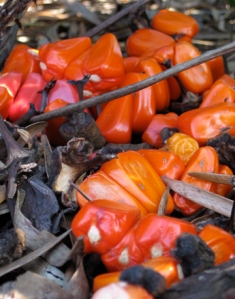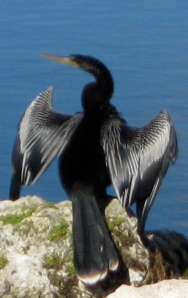 Location: Orlando, Florida from 1:00pm-2:00pm Weather: Sunny, 79°F – High: 79°F Low: 62°F
Location: Orlando, Florida from 1:00pm-2:00pm Weather: Sunny, 79°F – High: 79°F Low: 62°F
It’s December in Florida, which means I’m sitting on my bench (see the October post for more about “my bench”) in shorts and a t-shirt. I’m out later than usual and the light is certainly different, very bright and directly overhead. This time of day is quieter than the morning, only a few birds chirp in a nearby tree. A gentle breeze blows through, rustling the leaves of the trees on the island and the grasses that grow along the edge of the lake.
There haven’t been any drastic changes to the landscape since last month. The Pink Muhly Grass (Muhlenbergia capillaris) has lost its brilliant mauve colored ends, which are now a light tan color. The browning Cypress Trees (Taxodium distichum) continue to lose needles but if you think that means autumn has set in, just look through their thinning branches where you’ll see lush trees surrounded by green grasses.
 It’s during the month of November, and into December, the Florida Coontie plants (Zamia floridana, Z. integrifolia, Z. umbrosia) develop cones and set their seed. The seeds are a brilliant yellowish-orange color that slowly darkens to a deep reddish-orange color. Coontie plants are prevalent in Florida and are very slow growing. I find these plants fascinating because they are part of an order of plants called, Cycadales or Cycads. Many of these plants have been in existence since dinosaurs walked the earth over 200 million years ago. These are the direct descendants of plants that the herbivorous dinosaurs ate. How cool is that? If you live in Florida, you probably have one of these prehistoric plants growing in your backyard right now. So, next time you pass one, take just a second to marvel at the Jurassic leftover that’s slowly and steadily growing through yet another century.
It’s during the month of November, and into December, the Florida Coontie plants (Zamia floridana, Z. integrifolia, Z. umbrosia) develop cones and set their seed. The seeds are a brilliant yellowish-orange color that slowly darkens to a deep reddish-orange color. Coontie plants are prevalent in Florida and are very slow growing. I find these plants fascinating because they are part of an order of plants called, Cycadales or Cycads. Many of these plants have been in existence since dinosaurs walked the earth over 200 million years ago. These are the direct descendants of plants that the herbivorous dinosaurs ate. How cool is that? If you live in Florida, you probably have one of these prehistoric plants growing in your backyard right now. So, next time you pass one, take just a second to marvel at the Jurassic leftover that’s slowly and steadily growing through yet another century.
 On this nature walk I was lucky enough to spot an Anhinga (Anhinga anhinga …seriously) warming itself on the rocks that line the small pool under the bridge. These birds are common in Florida and are also known as Water Turkeys, Darters or Snake Birds because of their long, bending, snake-like necks. They often swim through the water with only their head out, then dive below the surface to fish. They can often be seen, as I saw, sunning themselves along the water’s edge with their wings outstretched to be dried and warmed. This day, as the Anhinga finished drying himself, he slipped into the water where he swam unseen, only to reemerge with a flopping fish in his beak. The little fish did its best to get away and I could see it wriggling furiously all the way down the bird’s throat, which I suspect is an odd feeling for both bird and fish.
On this nature walk I was lucky enough to spot an Anhinga (Anhinga anhinga …seriously) warming itself on the rocks that line the small pool under the bridge. These birds are common in Florida and are also known as Water Turkeys, Darters or Snake Birds because of their long, bending, snake-like necks. They often swim through the water with only their head out, then dive below the surface to fish. They can often be seen, as I saw, sunning themselves along the water’s edge with their wings outstretched to be dried and warmed. This day, as the Anhinga finished drying himself, he slipped into the water where he swam unseen, only to reemerge with a flopping fish in his beak. The little fish did its best to get away and I could see it wriggling furiously all the way down the bird’s throat, which I suspect is an odd feeling for both bird and fish.
I’m so glad that I get to welcome another month in this beautiful location, surrounded by such a wide variety of animals and plants. After just 3 months of nature walks I feel like I have been able to see some pretty unique things and this month has been no exception. I’ll leave you with more pictures of the Coontie plants and the Water Turkey’s fishing expedition. Until next month…this is December.
![]()
.
.
[slideshow]


7 comments for “The Nature Walk Project – Month 3: December”